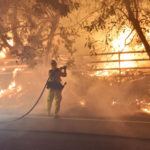A report from catastrophe modeling firm AIR Worldwide highlights “widespread flooding, landslides, wrecked roads and bridges, downed trees, and power outages” in the Philippines in the wake of Typhoon Koppu’s passage.
The storm has finally moved over the Island of Luzon in the Philippines, and is currently over the South China Sea. AIR said the storm is “weakening and moving northward, the Japan Meteorological Agency (JMA) has downgraded Koppu (known as Lando in the Philippines) to a tropical storm. The Philippine Atmospheric, Geophysical, and Astronomical Services Administration (PAGASA) has removed or downgraded public storm warnings in some areas.”
at AIR Worldwide scientist Christopher Bednarczyk said: “A notably slow-moving storm, Typhoon Koppu made landfall in Aurora Province near the town of Casiguran early Sunday morning local time. Rapid intensification occurred before landfall as the storm experienced very favorable environmental conditions (warm sea surface temperatures, high ocean heat content, and low vertical wind shear).
“According to the JMA, maximum sustained winds at landfall were approximately 185 km/h (115 mph) with a central pressure of 920 mb, making it a Category 4 storm on the Saffir-Simpson scale. The effects of land on the storm have produced a disorganized system with convection primarily located on the western side of the low-level circulation.”
In the near term, Koppu is expected to move slowly northeastward over the sea, impacting the Philippines for the next couple days. Flooding and landslides will continue to be key concerns as many locations, particularly the west coast of northern Luzon, will see even more heavy rainfall.
Bednarczyk added: “As it continues to move over open water, there may be some minor re-intensification of the storm’s winds, but its very slow movement should upwell and mix colder water from below the sea surface, inhibiting significant re-intensification. The forecast track in the medium range is for Koppu to move northeastward toward Taiwan or the Ryuku Islands of Japan.”
AIR explained that Luzon is the world’s 15th largest island and “northern Luzon experiences typhoons more frequently than any other part of the Philippines. The heavily populated Metro Manila region in the south, the nation’s economic and political center, was fortunately spared serious damage from Typhoon Koppu. Power outages however, impacted almost 10 percent of the Philippine’s population by Sunday afternoon.
Beyond Metro Manila there is little commercial or industrial activity in Luzon’s other regions, which are lightly populated and mountainous and/or agricultural. The mountainous northeastern section, for example, is the country’s second largest producer of rice and its top corn producer, and the central plains are the nation’s largest producer of rice. Bananas, mangoes, coconuts, pineapple, and coffee are also grown. Major crop damage is reported as a result of Koppu, with severe flooding of fields.”
Bednarczyk noted: “Typhoon winds can result in significant damage in the Philippines, but flooding is usually the principal cause of loss. So far, rainfall has been less than originally predicted by the numerical models, but Typhoon Koppu’s slow progress is still enabling it to deposit large amounts of precipitation.”
AIR reported that there have been “widespread landslides as well as riverine and flash floods,” which have “led to road and bridge blockages. The city of Baguio has already received more than 400 mm (15.7 in) of rainfall, with much more expected.
“Nueva Ecija Province has experienced severe flooding, with reports of water depths head-high near Cabanatuan. The town of San Antonio in central Luzon and many other communities have been cut off. As water flows from the mountains it will likely overburden river systems downstream. There is also concern about some dams: one of the largest in the Philippines, Magat Dam, came close to its critical and spilling level on Sunday.
“With moderate-to-heavy rains continuing, and with the flood risk far from over, some evacuated villagers are not yet being allowed home. Fishermen have been warned not to go to sea because of continued rough seas in the region, and schools in affected areas will remain closed through Tuesday.”
According to AIR, in the Philippines, “lighter materials—such as wood frame with galvanized iron or aluminum roofs—are often used for residential buildings in rural areas. Some damage to such structures has already been reported.
“Typhoon and flood damage are usually covered together in the Philippines and are offered under separate fire policies with named perils extensions. Given that insurance penetration is typically no more than 10 percent to 20 percent, insured losses are not expected to be significant as a result of this event.”
Source: AIR Worldwide
.
Topics Catastrophe Natural Disasters Flood
Was this article valuable?
Here are more articles you may enjoy.


 State Farm Seeking Large Rate Increases in Wildfire-Prone California
State Farm Seeking Large Rate Increases in Wildfire-Prone California  German Insurtech Wefox to Replace CEO After Board Rejects Mubadala Sales Plan
German Insurtech Wefox to Replace CEO After Board Rejects Mubadala Sales Plan  Allstate, Nationwide Post Dramatic Q12024 Homeowners Loss Ratio Drops: S&P
Allstate, Nationwide Post Dramatic Q12024 Homeowners Loss Ratio Drops: S&P  Supreme Court Overturns Chevron Rule in Blow to Regulators
Supreme Court Overturns Chevron Rule in Blow to Regulators 

